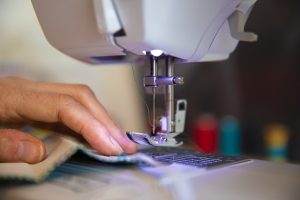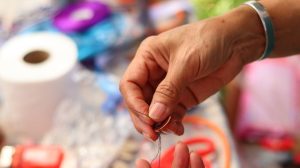Home sewing, particularly dressmaking had seen a resurgence among American women in as early as 1997. Based on a report issued in that year by the American Home Sewing and Craft Association, almost a third of adult women comprising the U.S. population ( then estimated at around 30 million), were already into sewing their own garments.
The resurgence came about, despite the removal of home economics as part of school curriculum. Economic reason was initially the main driving factor, because back in those days, only those with less money to spend took to home-sewing. Only the rich can afford to buy clothes off the rack. According to the trade organization’s survey, many of the home sewers had some college education and/or were taught how to sew by their mother or grandmother.
Yet it came to a point when sewing one’s own clothes was not only practical, but also fulfilling, as it gave women control over the style, color and fit of the garments they wore. Years later, making one’s own clothes became the “in” thing even among celebrities.
Researchers Define the Motivation Behind DIY Dressmaking
A new research paper published in August 2019 by Addie Martindale, an Assistant Professor of Fashion Merchandising and Apparel Design, at Georgia Southern University’s School of Human Ecology and Ellen McKinney, Associate Professor of Apparel, Events, and Hospitality Management Department of Iowa State University, gave focus on why women are motivated to sew clothes for themselves.
The two researchers developed a model of sewing motivations to illustrate the connection between the emergence of home sewing and its contribution to personal fulfillment among women. It demonstrated that
“Self-fulfillment is a recurring cycle that takes place each time the women created a new garment for themselves.”
UK Women Today Have Started Taking Up Home-Sewing as a Hobby
A 2017 research paper published by the Craft & Hobby Trade Association of UK (CHA-UK), reported that about 7.7 million Britons, mostly women, are now making their own clothes as their hobby. The number is growing since the study showed millios more have taken to home sewing, ever since the BBC launched “The Great British Sewing Bee.” Apparently, the competition, helped rekindle interest in becoming part of the maker movement.
Katharine Poulter, the commercial director of UK’s largest arts and crafts superstore Hobbycraft, said that just as the “Great British Bake-off” boosted the sales of home baking merchandise, retailers of sewing machines, bobbins, dressmaking patterns, shears, tailor’s chalk and threads are now reporting leaps in sales. According to Ms. Poulter, Hobbycraft’s 2016 sales of sewing and knitting patterns soared by 60%, and by almost 30% for sewing machines.
Patrick Grant, the Creative Director of Savile Row who sits as one of the judges in “The Great British Sewing Bee,” remarked that making something with your hands is a very therapeutic experience. Although home sewing and crafting in general went off the radar in the UK for 20 years, Mr. Grant says it is now “cool“ to make your own clothes.
He shared that when he was a kid, there was some kind of stigma to wearing homemade garments. That however, has completely changed because the status quo has been completely reversed.
Craig De Souza, the Executive Director of CHA-UK says “Learning how to do things is different now.
“If a person does not know how to sew and knit, he or she can simply learn from Youtube videos.”
.
 Somehow amidst a fascinating world full ofdigital creations, making things by using traditional sewing skills can bring a different kind of fulfilment to the creator. Actually, learning how to sew has never lost its popularity because it’s a transformative hobby that brings out the simple joys of crafting using your own hands and some basic sewing tools, including a conventional sewing machine.
Somehow amidst a fascinating world full ofdigital creations, making things by using traditional sewing skills can bring a different kind of fulfilment to the creator. Actually, learning how to sew has never lost its popularity because it’s a transformative hobby that brings out the simple joys of crafting using your own hands and some basic sewing tools, including a conventional sewing machine. Sewing is regarded by hobbyists as an artistic outlet as it allows them to express their creative ideas by way of threads and fabrics in creating a dress, a quilt or even a unique accessory. The enjoyment starts with the selection of patterns, oftentimes with intent to customize designs in ways that will reflect their individuality or artistic creativity.
Sewing is regarded by hobbyists as an artistic outlet as it allows them to express their creative ideas by way of threads and fabrics in creating a dress, a quilt or even a unique accessory. The enjoyment starts with the selection of patterns, oftentimes with intent to customize designs in ways that will reflect their individuality or artistic creativity.
 Sewing projects can serve as outlets for artistic skills and even enhance one’s problem-solving abilities. It gives a person ideas on how to create costumes or devise props for school presentations.
Sewing projects can serve as outlets for artistic skills and even enhance one’s problem-solving abilities. It gives a person ideas on how to create costumes or devise props for school presentations.